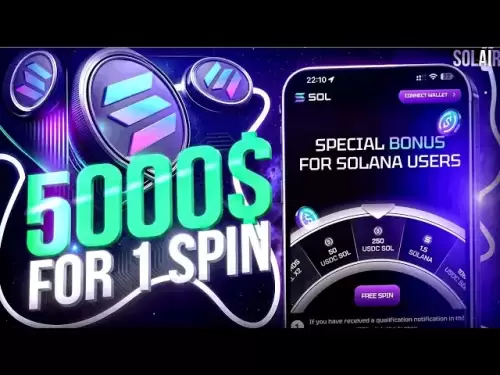-
 Bitcoin
Bitcoin $119,161.9671
1.52% -
 Ethereum
Ethereum $2,995.0722
2.34% -
 XRP
XRP $2.8555
5.32% -
 Tether USDt
Tether USDt $1.0002
0.00% -
 BNB
BNB $692.9308
1.48% -
 Solana
Solana $162.9611
1.87% -
 USDC
USDC $0.9999
0.00% -
 Dogecoin
Dogecoin $0.2014
2.84% -
 TRON
TRON $0.3032
0.90% -
 Cardano
Cardano $0.7464
6.51% -
 Hyperliquid
Hyperliquid $49.1533
5.71% -
 Stellar
Stellar $0.4773
24.77% -
 Sui
Sui $3.4979
3.93% -
 Chainlink
Chainlink $15.8552
6.01% -
 Hedera
Hedera $0.2401
23.85% -
 Bitcoin Cash
Bitcoin Cash $510.0474
0.97% -
 Avalanche
Avalanche $21.5550
4.82% -
 UNUS SED LEO
UNUS SED LEO $9.0389
-0.47% -
 Shiba Inu
Shiba Inu $0.0...01340
2.27% -
 Toncoin
Toncoin $2.9910
0.62% -
 Litecoin
Litecoin $96.4406
4.34% -
 Polkadot
Polkadot $4.0359
4.59% -
 Monero
Monero $338.4759
2.80% -
 Uniswap
Uniswap $8.6460
4.01% -
 Dai
Dai $0.9999
0.00% -
 Ethena USDe
Ethena USDe $1.0007
0.03% -
 Pepe
Pepe $0.0...01254
3.26% -
 Bitget Token
Bitget Token $4.3969
0.79% -
 Aave
Aave $312.2641
3.98% -
 Bittensor
Bittensor $397.0731
4.17%
How to test a used GPU before buying it for mining?
Test a used GPU for mining by checking temperatures, hash rates, and stability under load to ensure reliability and avoid hardware issues.
Jul 14, 2025 at 04:35 am

Understanding the Importance of Testing a Used GPU
When purchasing a used GPU for mining, ensuring its performance and reliability is critical. Mining puts significant stress on graphics cards, often leading to overheating, memory degradation, or even permanent damage. Therefore, testing a used GPU before purchase helps avoid costly mistakes. Buyers must verify that the GPU functions properly under load, has no hidden hardware issues, and can sustain prolonged mining sessions without crashing.
Mining GPUs are prone to wear and tear due to continuous operation at high intensity. This makes pre-purchase testing essential for identifying signs of deterioration such as thermal throttling, faulty VRAM, or unstable clock speeds.
Physical Inspection of the GPU
Before running any software tests, a visual inspection of the GPU is necessary. Start by examining the fan blades and heatsink for dust accumulation or physical damage. Excessive dust buildup may indicate poor maintenance, which could lead to overheating. Check for bent pins on the PCIe connector and ensure all power connectors are intact.
Look for signs of coil whine damage or capacitor bulging on the board itself. These symptoms often point to previous over-volting or inadequate cooling during mining operations.
- Inspect the backplate for scratches or warping
- Ensure all output ports (HDMI, DisplayPort) are functional
- Verify that the BIOS switch (if present) toggles correctly
Basic Software Setup for Testing
To test a used GPU effectively, you need a minimal system setup. This includes a compatible motherboard, CPU, RAM, and power supply. The GPU does not need to be installed in a full mining rig for initial diagnostics. A basic PC build with a monitor connected suffices for most tests.
Use a lightweight operating system like Windows 10 or Linux for quick booting and minimal background processes. Ensure all drivers are updated to their latest versions for accurate benchmarking results.
- Install GPU-Z for monitoring temperatures, voltages, and clock speeds
- Download FurMark or 3DMark for stress testing
- Use CrystalDiskInfo to check NVMe or SSD storage health if applicable
Running Stress Tests and Monitoring Performance
Once the system is ready, begin with a stress test using FurMark. This tool pushes the GPU to its limits and reveals any instability or overheating issues. Run the test for at least 15–20 minutes while monitoring temperature and power draw via GPU-Z.
A healthy GPU should maintain stable temperatures below 85°C under full load. If temperatures spike rapidly or exceed this threshold, it indicates poor thermal paste application or degraded cooling components.
- Observe screen for artifacts such as flickering or color distortion
- Check for sudden crashes or blue screens during the test
- Monitor power consumption to detect abnormal spikes
Checking Hash Rates and Stability Under Mining Conditions
After confirming general stability, simulate real-world mining conditions. Install a mining software like NiceHash, Claymore, or PhoenixMiner and configure it to mine Ethereum or another popular cryptocurrency. Allow the GPU to run for several hours while tracking its performance metrics.
Stable hash rates without frequent drops suggest healthy VRAM and core functionality. Fluctuating or declining hash rates may signal failing memory modules or driver-related issues.
- Compare expected vs actual hash rate based on the GPU model
- Monitor temperatures again during extended mining simulation
- Check logs for rejected shares or connection errors
Frequently Asked Questions
What tools are best for checking GPU memory errors?
Tools like MemTestG80 or Radeon Memory Scanner are ideal for detecting VRAM issues. These programs specifically target memory modules and expose any faults that may affect mining performance.
Is it safe to test a used GPU without knowing its previous usage history?
Testing is safe but always proceed with caution. Use a reliable PSU and ensure proper grounding. If the GPU shows erratic behavior during tests, avoid pushing it further to prevent potential system damage.
How long should I test a used GPU before deciding to buy?
A minimum of 3–4 hours of continuous stress and mining tests is recommended. This duration allows enough time to observe thermal behavior, stability, and overall performance consistency.
Can I trust benchmarks alone to assess GPU condition?
No, benchmarks provide performance data but may not reveal underlying hardware issues. Combining benchmarks with memory scanning tools and real-world mining simulations gives a more comprehensive evaluation.
Disclaimer:info@kdj.com
The information provided is not trading advice. kdj.com does not assume any responsibility for any investments made based on the information provided in this article. Cryptocurrencies are highly volatile and it is highly recommended that you invest with caution after thorough research!
If you believe that the content used on this website infringes your copyright, please contact us immediately (info@kdj.com) and we will delete it promptly.
- PENGU Meme Coin Rally: Eyeing New Targets Amid Crypto Market Surge
- 2025-07-14 11:10:13
- VeChain, Render, and Near Protocol: Riding the Crypto Wave in 2025
- 2025-07-14 10:30:12
- Binance, Bitcoin, Prediction: Decoding the Crypto Crystal Ball
- 2025-07-14 10:30:12
- Bitcoin Adoption, Cryptocurrency, Smarter Alternative: What's the Hype?
- 2025-07-14 11:10:13
- Kenya Embraces the Future: Digital Tokens on the Solana Blockchain
- 2025-07-14 11:15:11
- Little Pepe Presale Heats Up: Is This Meme Coin the Real Deal?
- 2025-07-14 11:30:12
Related knowledge

How are crypto mining profits taxed?
Jul 14,2025 at 12:28am
Understanding Cryptocurrency Mining and TaxationCryptocurrency mining involves validating transactions on a blockchain network and earning rewards in ...

How to keep a mining rig cool
Jul 12,2025 at 01:42pm
Understanding the Importance of Cooling in Mining RigsCryptocurrency mining is an intensive process that places heavy demand on hardware components, p...

How much does it cost to start crypto mining?
Jul 13,2025 at 12:22am
Understanding the Basic Costs of Crypto MiningStarting crypto mining involves several upfront and ongoing expenses. The primary costs include hardware...

What is the most profitable crypto to mine?
Jul 13,2025 at 07:00am
Understanding Mining Profitability in CryptocurrencyWhen evaluating the most profitable crypto to mine, it's essential to consider several factors tha...

What do I need to start mining crypto?
Jul 13,2025 at 12:28am
Understanding the Basics of Crypto MiningCrypto mining is the process by which transactions are verified and added to a blockchain, and new coins are ...

How does crypto mining work?
Jul 13,2025 at 11:01am
Understanding the Basics of Crypto MiningCrypto mining is the process through which new cryptocurrency coins are introduced into circulation and trans...

How are crypto mining profits taxed?
Jul 14,2025 at 12:28am
Understanding Cryptocurrency Mining and TaxationCryptocurrency mining involves validating transactions on a blockchain network and earning rewards in ...

How to keep a mining rig cool
Jul 12,2025 at 01:42pm
Understanding the Importance of Cooling in Mining RigsCryptocurrency mining is an intensive process that places heavy demand on hardware components, p...

How much does it cost to start crypto mining?
Jul 13,2025 at 12:22am
Understanding the Basic Costs of Crypto MiningStarting crypto mining involves several upfront and ongoing expenses. The primary costs include hardware...

What is the most profitable crypto to mine?
Jul 13,2025 at 07:00am
Understanding Mining Profitability in CryptocurrencyWhen evaluating the most profitable crypto to mine, it's essential to consider several factors tha...

What do I need to start mining crypto?
Jul 13,2025 at 12:28am
Understanding the Basics of Crypto MiningCrypto mining is the process by which transactions are verified and added to a blockchain, and new coins are ...

How does crypto mining work?
Jul 13,2025 at 11:01am
Understanding the Basics of Crypto MiningCrypto mining is the process through which new cryptocurrency coins are introduced into circulation and trans...
See all articles

























































































